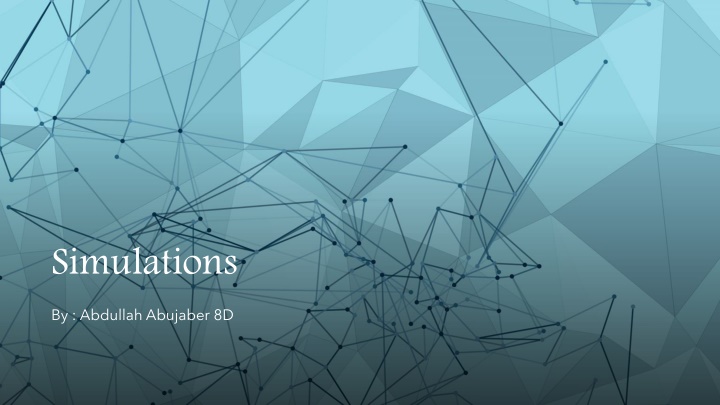
Understanding Simulations: Key Concepts and Applications
Discover what simulations are, how they work, various types of simulations, advantages, and disadvantages. Learn how simulations imitate real-world processes and systems using models, providing accurate results, aiding in education, and offering insights for different industries.
Download Presentation

Please find below an Image/Link to download the presentation.
The content on the website is provided AS IS for your information and personal use only. It may not be sold, licensed, or shared on other websites without obtaining consent from the author. If you encounter any issues during the download, it is possible that the publisher has removed the file from their server.
You are allowed to download the files provided on this website for personal or commercial use, subject to the condition that they are used lawfully. All files are the property of their respective owners.
The content on the website is provided AS IS for your information and personal use only. It may not be sold, licensed, or shared on other websites without obtaining consent from the author.
E N D
Presentation Transcript
Simulations By : Abdullah Abujaber 8D
What is a simulation A simulation imitates the operation of real world processes or systems with the use of A simulation imitates the operation of real world processes or systems with the use of models. The model represents the key behaviors and characteristics of the selected process models. The model represents the key behaviors and characteristics of the selected process or system while the simulation represents how the model evolves under different conditions or system while the simulation represents how the model evolves under different conditions over time. over time.
How a simulation works Simulation works by intuitive simulation software to create a visual mock-up of a process. This visual simulation should include details of timings, rules, resources and constraints, to accurately reflect the real-world process, this can be applied to a range of scenarios, for example, you can model a supermarket and the likely behaviors of customers as they move around the shop as it becomes busier. This can inform decisions including staffing requirements, shop floor layout, and supply chain needs.
Some Types of simulations 1.Automotive simulations 2. and urban planning simulations 3.Disaster preparation simulations 4.Engineering systems 5.Flight simulation 6.Robotics 7.And many more
ADVANTAGES 1) 1) Give accurate results Give accurate results ::Most of the time the result of the simulation is accurate than doing analytical or practical testing on the actual system. 2) Helps students: Teachers can do a simulation of the system by computer and explain to students. 3) 3) Animation and modeling : Animation and modeling : With simulation, engineers can see the actual product (e.g. car) without practically building it. They can change the look and feel of the product during modeling.
DISADVANTEGES 1)expensive: Sometimes it costs more money to do simulation then making the product. 2)Takes a long time : It takes a long time to set up and test a simulation model. This is because simulation takes a lot of data to be input. 3)computer limitation :Complex simulation involves a computer with higher memory and processor speed. This is another drawback of simulation.
